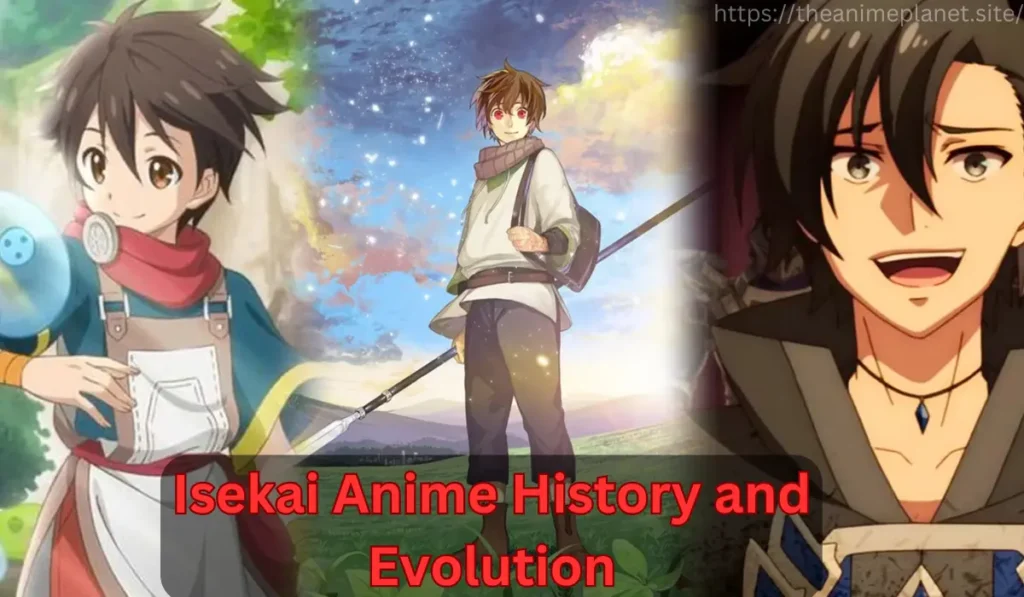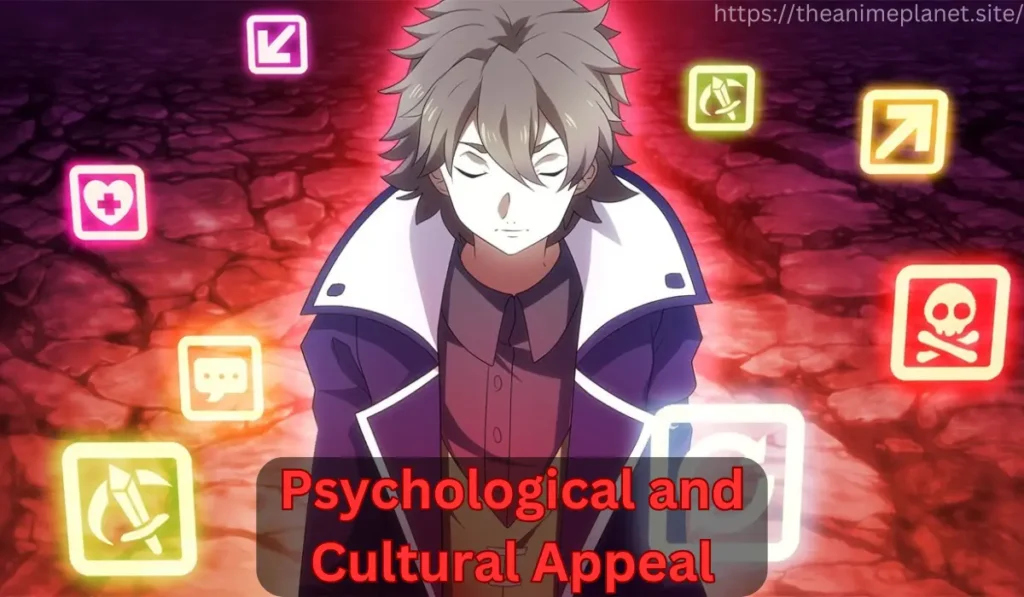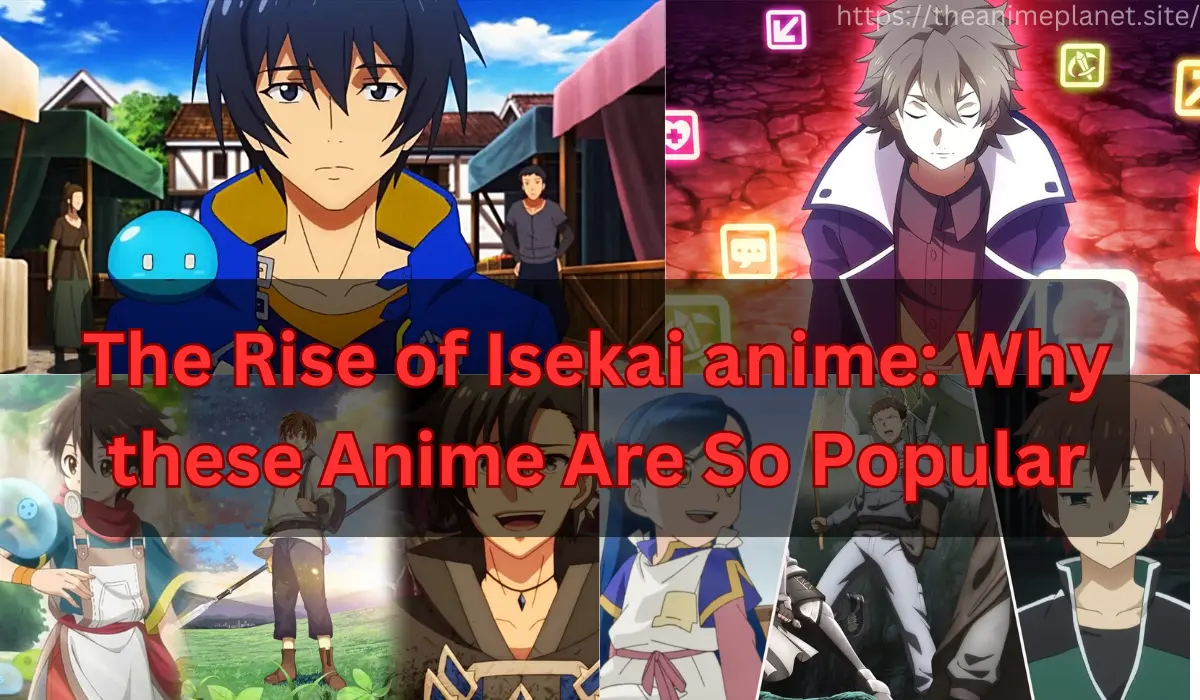Over the past decade, one genre isekai anime has swept through the anime community, captivating fans across Japan and around the globe: isekai. Translating roughly to “another world,” isekai anime have evolved from obscure niche works to a dominant force in the industry. In this blog, we explore the history, key elements, cultural and psychological appeal, market success, and future prospects of isekai anime. We will analyze everything from isekai anime history and evolution to the narrative structure and world-building techniques that set these series apart. Join us as we dive deep into the reasons for isekai anime popularity, the trends fueling its mainstream success, and what makes the isekai genre so culturally significant.
1. A Brief Historical Overview: Isekai Anime History and Evolution
The roots of isekai can be traced back to folklore and classic literature. Stories of ordinary people whisked away to fantastical realms have appeared in Japanese mythology for centuries and echo Western tales like Alice’s Adventures in Wonderland and The Chronicles of Narnia. However, the modern isekai anime boom began in earnest in the 1990s and early 2000s when early series such as Fushigi Yûgi and The Vision of Escaflowne set the stage for transporting audiences to alternate worlds. As the popularity of web novels surged on platforms like Shōsetsuka ni Narō, a treasure trove of “another world” stories began to emerge, sparking a renaissance in isekai anime history and evolution .

The success of these online stories laid the groundwork for a full-blown isekai revolution. One of the pivotal moments came with Sword Art Online—a series that not only popularized the genre but also highlighted the role of game-like worlds and virtual reality in modern storytelling. Soon after, titles such as Re:Zero − Starting Life in Another World, KonoSuba: God’s Blessing on This Wonderful World!, and That Time I Got Reincarnated as a Slime captivated audiences worldwide. These series introduced viewers to the core isekai anime tropes and themes that have now become almost ubiquitous in the genre, marking a significant leap in both isekai anime evolution and industry trends .
In recent years, the sheer number of isekai series produced each season has grown dramatically—a testament to the strong isekai anime market growth. With more than half of all isekai anime in history being produced since 2020, the trend has firmly established isekai as a powerhouse in modern anime. The evolution from early experiments to a full-fledged industry phenomenon is evident not only in the increasing volume of titles but also in the refined narrative structures and intricate world-building techniques that define many contemporary series.
2. The Anatomy of Isekai: Tropes, Themes, and Storytelling Techniques
A deep dive into isekai anime reveals a remarkable consistency in its narrative elements. At its core, the genre revolves around the transformation of a character from the mundane world into a hero—or sometimes a reluctant participant—in an extraordinary realm. These narrative choices are central to isekai anime storytelling and have helped shape the unique isekai anime narrative structure that fans adore.

2.1. Key Tropes and Themes
Several recurring tropes have come to define the genre. One of the most prominent is the concept of reincarnation or transportation, where a character (often an ordinary person) is thrust into another world via a supernatural event. This trope, a cornerstone of isekai anime tropes, not only provides a built-in mechanism for isekai anime escapism but also allows for a deep exploration of identity transformation. Whether it is Re:Zero’s cycle of death and rebirth or the unconventional humor of KonoSuba, these narrative devices underpin the storytelling and set up a framework for character development and narrative progression.
Another essential theme is the “game-like” quality of many isekai worlds. Series like Sword Art Online and That Time I Got Reincarnated as a Slime create intricate worlds with clearly defined rules—often mirroring video game mechanics—that guide both the anime world-building and the isekai anime storytelling techniques. These mechanics often include leveling systems, skill progression, and quest structures that lend a familiar structure to an otherwise fantastical setting. They contribute to the overall isekai anime appeal and help explain the reasons for isekai anime popularity among younger audiences and gamers alike.
Additionally, many isekai series blend comedy with dark themes. KonoSuba is celebrated for its satirical take on the genre, while Re:Zero often explores psychological depth and existential angst. Such narrative diversity enhances the isekai anime narrative appeal and ensures that the genre remains fresh despite recurring themes. This blend of humor, tragedy, and action is a major part of the isekai anime storytelling and is critical in driving fan engagement.
2.2. Narrative Structure and Character Development
The isekai anime narrative structure typically follows a three-act formula: the protagonist’s departure from the mundane world, their trials and growth in the fantastical realm, and ultimately, their transformation into a hero or a more complex character. This structure allows for expansive anime character development. For instance, in Mushoku Tensei: Jobless Reincarnation, the protagonist Rudeus evolves from a disillusioned individual into a determined, multifaceted character, undergoing profound psychological and emotional growth. Such development is a prime example of anime character development and underscores the psychological appeal that many viewers find irresistible.
Equally important is the emphasis on isekai anime world-building. Creators craft detailed settings that are rich in lore and cultural significance, inviting viewers to lose themselves in a realm that feels both alien and oddly familiar. Whether it’s the medieval fantasy aesthetics or futuristic landscapes, effective world-building is one of the primary anime success factors and has driven widespread isekai anime mainstream success.
The use of isekai anime storytelling techniques—such as non-linear narratives, flashbacks, and meta-commentary—also plays a crucial role in how these stories resonate with audiences. Some series even subvert traditional narrative expectations, offering layered storytelling that invites viewers to explore deeper themes about power, responsibility, and the nature of reality itself.
3. Psychological and Cultural Appeal: The Power of Escapism and Relatability
One of the key reasons for isekai anime popularity is its potent psychological appeal. At a time when many people feel overwhelmed by the challenges of modern life, isekai offers an alluring escape—a journey into worlds where problems can be reset, and the protagonist has the chance to reinvent themselves from scratch. This is the very essence of isekai anime escapism.

3.1. Escapism and the Search for Meaning
The idea of leaving behind a dreary reality to explore a vibrant, fantastical realm resonates deeply with viewers. Isekai anime often tap into the universal desire for a second chance—a chance to start over in a world that offers endless possibilities. For many, the fantasy of escaping daily struggles and the monotony of routine life is a compelling aspect of the genre. This desire is reflected in numerous series, where protagonists use their newfound abilities to challenge the status quo and pursue personal growth. Such narratives underline the psychological appeal of isekai anime and explain why they are so beloved by diverse isekai anime audiences
.
Furthermore, anime frequently explore themes of self-discovery and empowerment. When a character is thrust into another world, they often must learn to harness new abilities, build relationships, and overcome adversity. These stories offer a metaphor for personal transformation—a journey from weakness to strength, from despair to hope. The psychological appeal of this transformation is immense, as it mirrors the real-life desire to improve oneself and overcome challenges.
3.2. Cultural Impact and Significance
Beyond the individual psychological appeal, anime have had a profound cultural impact. They serve as a lens through which societal issues and modern anxieties can be examined. In many ways, isekai anime reflect contemporary concerns—whether it’s the disillusionment with a stagnant society or the yearning for innovation and change. As these series become cultural touchstones, they influence everything from fashion and social media trends to the broader discourse on creativity in Japanese popular culture. The isekai anime cultural impact is evident not only in the massive fanbase but also in the extensive merchandise and online communities dedicated to discussing every nuance of these series.
This cultural significance is further highlighted by the role isekai plays in reshaping modern Japanese identity. As isekai anime continue to dominate television schedules and streaming platforms, they contribute to a dynamic interplay between tradition and innovation. They blend age-old mythologies with modern storytelling techniques, resulting in a genre that is both nostalgic and futuristic. The isekai anime cultural significance can be seen as a response to the rapid changes in society—an attempt to find balance between the old and the new while offering a space where viewers can project their aspirations and fears.
4. Market Trends and Industry Insights: Isekai Anime’s Mainstream Success
The meteoric rise of isekai anime is not just a cultural phenomenon—it’s also a market triumph. Industry analysts have observed that isekai anime enjoy a level of consistent success that makes them one of the most lucrative genres in the industry.

4.1. Market Growth and Industry Trends
In recent years, the isekai genre has experienced explosive market growth. With studios churning out new isekai series almost every season, the genre has become a mainstay in the anime production pipeline. This surge in production is both a cause and effect of isekai anime popularity; as more series are produced, more viewers are drawn to the genre, which in turn fuels further investment. The rapid expansion of the isekai anime fanbase and the widespread isekai anime market growth have made it a critical pillar in the anime industry’s revenue streams .
Studios and streaming platforms alike have taken note of these trends. Major distributors such as Crunchyroll and Netflix now devote significant resources to acquiring and dubbing isekai titles, reflecting the broad isekai anime audience demographics that span from teens to adults. This industry-wide embrace of the genre is a testament to its proven track record as a safe and profitable investment. The steady rise in viewership numbers and the expansion of international markets underscore that the reasons for isekai anime popularity are not merely anecdotal—they are backed by measurable success in the global marketplace.
4.2. Success Factors and Fan Engagement
Several factors contribute to isekai anime success factors. First is the genre’s inherent versatility: it can blend elements of adventure, romance, comedy, horror, and even philosophical inquiry. This mix of genres ensures that there is something for everyone, broadening the isekai anime audience and boosting fan engagement. Series like Re:Zero, KonoSuba, and That Time I Got Reincarnated as a Slime each offer a different flavor of isekai anime appeal, catering to diverse tastes while still adhering to familiar tropes.
Fan engagement in the isekai community is another crucial factor. Active online communities, social media forums, and fan conventions are replete with discussions on isekai anime storytelling, isekai anime world-building, and even critiques on isekai anime narrative structure. This vibrant engagement helps sustain interest and encourages word-of-mouth promotion, further propelling the genre’s mainstream success. The phenomenon of fan art, cosplay, and even fan fiction—all part of the broader isekai anime fanbase—demonstrates the depth of isekai anime fan engagement and highlights the significant role that audience demographics play in driving market trends.
Moreover, critical reception of isekai anime has generally been positive. While some critics point out that the genre can be formulaic at times, many reviews praise the emotional depth, innovative storytelling techniques, and high production values of standout series. This isekai anime critical reception has, in turn, reinforced its reputation as a genre with lasting isekai anime narrative appeal.
5. The Future of Isekai: Prospects and Predictions
Looking ahead, the future prospects for isekai anime remain bright. As the genre continues to evolve, creators are experimenting with new subgenres and narrative devices to keep the material fresh and engaging. Here are some of the trends and developments we can expect to see in the coming years.
5.1. Innovation in Narrative and World-Building
One of the most exciting aspects of the isekai genre is its capacity for reinvention. While many series rely on familiar isekai anime tropes, recent works have begun to push the boundaries of isekai anime storytelling. Creators are now incorporating more sophisticated narrative structures and delving deeper into character psychology and development. For example, series like Mushoku Tensei: Jobless Reincarnation and Re:Zero have demonstrated that there is still ample room for isekai anime character development and nuanced storytelling—even within a formulaic framework.
Future isekai projects are likely to experiment further with non-linear narratives, meta-commentary, and even deconstructions of the genre itself. As audiences become more discerning, there will be a premium on originality and innovation. This will likely drive the creation of hybrid subgenres, such as “villainess isekai” or “reverse isekai,” where the roles of hero and antihero are subverted, and traditional expectations are challenged. These innovations not only promise to enhance the isekai anime narrative appeal but also position the genre to continue its mainstream success well into the future.
5.2. Expanding Global Reach and Audience Demographics
The international appeal of isekai anime shows no signs of waning. With streaming services making these series more accessible than ever, the isekai anime audience is expanding rapidly across diverse regions and age groups. Data suggest that the international viewership of isekai titles has grown significantly in the past few years, making the genre a truly global phenomenon. In fact, the ongoing investment by major platforms and the adaptation of isekai series into multiple languages are clear indicators of isekai anime market growth and isekai anime audience demographics shifting toward a more diverse, international fanbase.
This global expansion is likely to bring new cultural influences into isekai anime, further enriching its world-building and narrative techniques. As international writers and creators contribute to the genre, we may see a blending of Eastern and Western storytelling traditions, which could lead to even more innovative and culturally significant works. The increasing cross-pollination of ideas promises to enhance both isekai anime cultural impact and its future prospects on a global scale.
5.3. Fan Engagement and Industry Investment
The strength of the isekai fanbase is one of the key pillars supporting its future. As online communities continue to thrive, the level of isekai anime fan engagement is expected to grow further. Interactive events, fan conventions, and dedicated social media channels ensure that fans remain at the heart of the isekai anime industry trends. This engagement not only drives sales and viewership but also informs future production decisions, ensuring that the genre evolves in tandem with audience expectations.
In addition, as studios and distributors see sustained success, there is a strong incentive to experiment with different isekai anime storytelling techniques and production values. Higher budgets and more creative freedom may lead to more polished adaptations and original series that push the envelope of what is possible in animation. The cycle of innovation driven by fan feedback and industry investment creates a positive feedback loop that will likely cement isekai’s position as a leading genre in the years to come.
FAQ
What is isekai anime?
Isekai anime are series in which characters from the real world are transported, reincarnated, or otherwise thrust into an alternate, fantastical realm. These shows typically explore themes of transformation, adventure, and escapism.
Why has isekai become so popular?
The genre’s popularity stems from its unique blend of escapism, relatable character development, and imaginative world-building. Viewers are drawn to the idea of starting over in a world full of new possibilities—a powerful counterpoint to everyday challenges.
What are some common tropes in isekai anime?
Key tropes include reincarnation or transportation to another world, game-like mechanics such as leveling systems, overpowered protagonists, and a mix of comedy with darker or more dramatic themes. These recurring elements help create familiarity while still offering fresh narratives.
What distinguishes reincarnation isekai from teleported isekai?
In reincarnation isekai, a character dies in their original world and is reborn with a new identity, often allowing for significant personal transformation. In teleported isekai, the protagonist is suddenly transported into another world without losing their original identity, which can result in a more gradual adaptation to the new setting.
How does isekai anime provide escapism?
Isekai anime transport viewers to worlds vastly different from their own—often filled with magic, adventure, and opportunity. This shift from the mundane to the extraordinary offers a mental and emotional escape, allowing audiences to explore idealized versions of personal growth and empowerment.
What role does world-building play in the appeal of isekai?
Detailed, immersive settings are a hallmark of isekai. By creating expansive worlds with unique cultures, histories, and rules, creators offer viewers a deep dive into a universe that feels both alien and intriguing. This meticulous world-building is essential for engaging the audience and reinforcing the fantasy’s believability.
Which series are considered notable examples of the isekai genre?
Some standout series include Sword Art Online, Re:Zero − Starting Life in Another World, KonoSuba: God’s Blessing on This Wonderful World!, and That Time I Got Reincarnated as a Slime. Each series brings its own twist to common isekai tropes, contributing to the genre’s diversity and appeal.
How has the market for isekai anime evolved recently?
In recent years, isekai anime have experienced explosive market growth, with production volumes increasing dramatically. The genre’s ability to attract both domestic and international audiences has led to significant investments by studios and streaming platforms, ensuring its position as a major revenue driver.
What future trends can we expect for isekai anime?
Future developments are likely to include greater narrative innovation, such as non-linear storytelling and meta-commentary, as well as the emergence of hybrid subgenres (like “villainess” or “reverse” isekai). Additionally, the genre’s expanding global audience may inspire a fusion of Eastern and Western storytelling techniques.
How do cultural and psychological factors contribute to isekai’s success?
Isekai anime resonate deeply because they tap into universal desires for renewal and self-improvement. They mirror modern anxieties—such as the need to escape societal pressures—and provide a canvas for exploring personal transformation. Culturally, they offer a blend of traditional myth and modern narrative that appeals to diverse audiences, cementing the genre’s significance in today’s media landscape.
6. Conclusion
The rise of isekai anime is a multifaceted phenomenon driven by a confluence of historical precedent, narrative ingenuity, psychological appeal, and robust market trends. From its humble origins in folklore and early experimental series to its current status as a cultural juggernaut, isekai has transformed the way we experience anime. The genre’s popularity is built on its consistent ability to offer escapism, foster personal transformation, and create immersive worlds that invite viewers to dream—and to dare to believe in a better version of themselves.
As we have seen, the key to isekai’s enduring success lies in its masterful blending of familiar tropes with innovative storytelling techniques. Whether through the captivating narrative structure of Re:Zero, the humor and heart of KonoSuba, or the expansive world-building in That Time I Got Reincarnated as a Slime, these series resonate deeply with audiences because they speak to universal human desires for renewal and adventure. They provide a mirror to our own struggles and aspirations, offering both a retreat from the mundane and a blueprint for personal growth.



